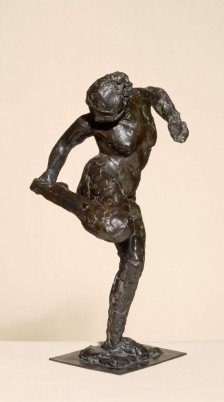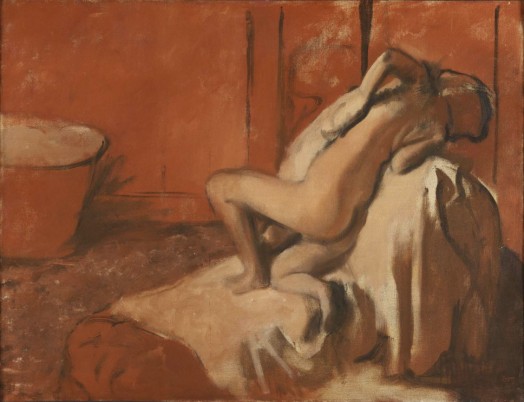
Of all the artists who came to be known as Impressionists, with their emphasis on the effects of light and color -- plein air painting -- and focus on outdoor motifs, it was Edgar Degas who held onto the tradition of the figure as both subject and inspiration. In this aspect of his work he was, in some ways, the last artist of his generation to incorporate the long-standing belief that the depiction of people, whether heroic, iconic, or merely quotidian, was the noblest achievement of a painter.
When asked why he painted the ballet, Degas said, "Because it is all that is left us of the combined movement of the Greeks." This justification is what one would expect, based on his unwavering interest in the subject of the figure. Degas could see a Venus or Nike adjusting a sandal in the ballerina fixing a slipper ("Dancer Looking at the Sole of her Right Foot" [1896–1911], shown at left). Similarly, in 1856 he saw the Parthenon figures and Attic vase painting and translated those into images of the dancer Eugénie Fiocre. Like the Greeks, he believed in the primacy of the human form as the wellspring of art. His "Scene of War in the Middle Ages" (1863-65) and "Young Spartans Exercising" (1860-62) drew their compositions from Greek histories.
Degas's painting methods embraced some of the exacting disciplines of the ballet; he often mimicked the movements and positions of his models in the studio as he worked, as if rehearsing for a performance himself. The impact of his work may be diminished with the passing of time (not to mention the countless museum gift shop calendar reproductions), and the modern viewer may miss some important details, having become too familiar with the pictures. At the time he was making them, however, reviews mentioned his "extraordinary alertness to common and unidealized fact" and his "vulgar awkwardness about some of the pink legs...scantily endowed with beauty."
 In After the Bath (Woman Drying Herself) (1896) [right] with its suggestion of Rubens's"Diana" or Rembrandt's "Bathsheba," Degas updated the genre of the bather by painting working-class women (read: dancers and prostitutes), not mythological or Biblical figures. With their backs turned to the viewer as they bathe, comb their hair, and so on, they are oblivious to being observed, or, as Degas wrote, "It is as though you were looking through a keyhole."
In After the Bath (Woman Drying Herself) (1896) [right] with its suggestion of Rubens's"Diana" or Rembrandt's "Bathsheba," Degas updated the genre of the bather by painting working-class women (read: dancers and prostitutes), not mythological or Biblical figures. With their backs turned to the viewer as they bathe, comb their hair, and so on, they are oblivious to being observed, or, as Degas wrote, "It is as though you were looking through a keyhole."
Degas's failing eyesight may have resulted in more simplified compositions, especially in his pastels. The influence of van Gogh, Gauguin, and others may have led him to brighter colors, more expressionist gesture, and simplified compositions. In his later work he especially captured the figure in movement (for example, "The Tub" [1886]), which the advent of photography was making obsolete. It is arguably fair to say that Degas, a 19th-century artist who lived well into the 20th century, brought to the portrayal of the nude some of the same seismic changes that Cezanne did to landscape. Degas's influence in that respect was incalculably important; Picasso, Matisse, de Kooning, and Bacon would continue these explorations. Even today, painters, whether consciously or not, still draw new meanings from his constant searching of the figure for inspiration. Vincent van Gogh, in a letter to Gaugin, wrote that the "calm and modeled nudes of Degas have a kind of perfection that, like coitus, can make the infinite tangible for us."
